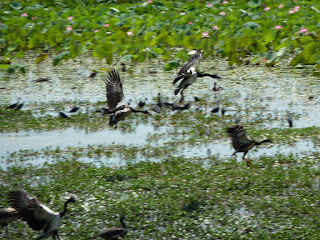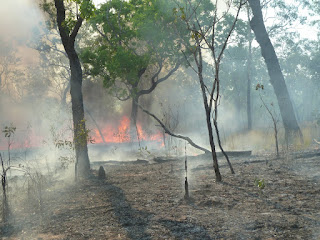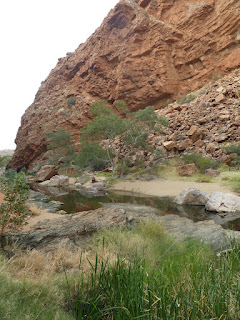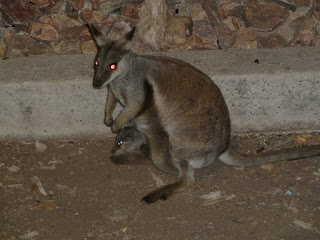We woke up early and hit the road for Kakadu National Park, stopping only for gas and to mail postcards from the town of Humpty Do. We stopped at the entrance sign to the park, which was the source of a great photo op, and also the location of a geocache. Unfortunately, we were primarily thwarted by a busload of tourists who took their time milling around, taking pictures and wasting time. Eventually they were off, and we got our own photo op and scored that geocache which was home to a travel bug in the form of a lure that we took with us.
It was hotter than heck, and extremely humid in the buildup to the rainy season in the Top End. Tempers flare easily here, and I can see why. Luckily we were too happy to be here to get uptight. Our first stop was a hike around some floodplains that were quite dry, but afforded views of an incredible amount of waterfowl, both from a lookout and from afar. We hoped to glimpse a croc, but alas, it was not to be. The hike was at least a two mile loop, and I was getting overheated, but it was still very interesting. We also did some hikes out to see indigenous rock art, and I saw many examples that I’d seen depicted elsewhere, which was neat. Some of them had interpretations, as well. My favorite hike, however, was a short one along a boardwalk. I really hoped to see some herps, but nothing was spotted, only fish, probably barramundi. Lots of birds too, of course. Boat tours would set off from this location, too, and we considered doing one, but it would have taken too long and we’d have needed to stay another day in the area. The tour guaranteed many croc sightings, but we’d have to pass, and that was disappointing. We did find our way over to the nearby food court and were excited to see we could get a platter of foods including barramundi pies, kangaroo skewers, water buffalo sausage, and crocodile spring rolls!! We were so excited to finally try croc, but unfortunately it was so sparse in those spring rolls that you really couldn’t tell if it was any good or not. Oh well. The water buffalo was a neat surprise, and pretty good, too. So that was something!
It was getting late at this point, so we made our way out of the park, stopping at every waterway with hopes of spying a croc, but to no avail. We did spook a mob of wallabies and saw some impressive storklike birds, and most excitingly several water buffalo who thundered into the bush upon our arrival, but no crockers. We continued down the road, met up with the Stuart Highway, and wound up spending the night at the same pull off at which we’d slept two nights prior. It was a bit colder, but still quite tolerable.
Sept. 29th
We woke up quite early and headed south along the Stuart Highway. On our way north, we’d wanted to stop at a historic and famous site known as Daly Waters Pub, but we’d passed by too late at night. This time, we hoped we’d be able to do breakfast there. On our way, we passed by the old WWII hangars that made Daly Waters so famous. Australia’s first international airport, during the war, Daly Waters served the military. Prior to that, this area, known for its springs, was a center for cattlemen, and the pub sprang up to cater to them. Much to our delight, it was open, and quite worth the visit. Trying to describe Daly Waters is an exercise in insanity. It’s a rough-seeming outback pub full of memorabilia from the multitudes of people who have visited throughout the decades. Hanging from the walls and ceiling are all numbers of things from banknotes to bras, postcards to panties, license plates, stubby holders (Aussies know what I mean) (Ok, beer cozies…), and things ranging from mundane to ridiculous. It’s enough to stun your senses. We sidled up to the bar and the friendly tender, who was a young guy from the UK, cheerfully took our order. Nate had the pancakes and I had some lovely omelets. While we were sitting down to eat and enjoying the décor, we were greeted by a gigantic double decker luxury charter bus that pulled up packed to the gills with teenagers (possibly 20-somethings). An incomprehensible whirlwind of noise and commotion converged on this formerly quiet outback pub, and Nate and I sped up our meal. Despite the sudden turmoil, we made sure to explore the location, both inside and out, before hitting the pavement and getting the heck out of the insanity.
We pressed onward this day, which would prove to be one of our most strenuous and least interesting of the trip. Eventually we bid adieu to the Stuart Highway at Three Ways, and continued east down the Barkly Highway. We only really stopped for gas and in search of any treats we could find to help break up the drive. Believe me, there is a whole lot of nothing along the Barkly Highway – it’s probably one of the most desolate stretches in Australia, easily beating out the Stuart Highway. Not much in the way of scenery, only flat scrublands and grazing, we hardly saw any wildlife. Interestingly, Barkly is designated Rte. 66 in Australia, and it bears no resemblance to ours at all save for the fact that it is a two lane highway. There is certainly no kitsch or whimsy to go along with the name, not that there should be. Still, I found that quite interesting.
Onward we pressed, heading east for a long, long time. We did stop at the border of Northern Territory and Queensland for a photo op, just glad to be out of the NT for our rental car’s sake. Continuing on, we eventually stopped in the town of Mt. Isa for dinner. It was getting dark, and we were extremely tired, so we weren’t in any mood to search around for restaurants, not that any would have been open if we had. We gave in and had dinner at the local McDonalds, which was absolutely hopping. Oh my gosh, it was the best meal ever. No joke. I ordered a Happy Meal and had to go back when they forgot my pickles and toy (um, hello?! Haha!), but once everything was set, it was soooo good. I even got my first Australian soda from a fountain. It was even better because of the cane sugar they use instead of corn syrup. The fries are cooked differently, too, and don’t leave you feeling greasy and sick. It just seemed healthier. And the new McCafe trend going on here in the states was taken to a whole new level with a separate area at which to order that genre of foodstuffs. I really don’t like McD’s, but this hit the spot like no other. It, too, was a bit of a madhouse, being full of teeny-boppers, but such is life!
Now Mt. Isa is an interesting town, and I really wish that we’d have gotten there earlier to truly see some of it. It is said that you’re not truly an Australian until you’ve visited this place, so I guess that makes us more Aussie than a lot of the population! Mining is its main purpose, producing lead, silver, copper and zinc. It’s also considered the largest city in the world (in jurisdiction, anyway) stretching around 188 km across. Despite being in the most barren desert, it has an artificial lake rife with water activities like fishing and boating. It is also noted for its historic WWII underground hospital. Still, it was dark, and we couldn’t tarry. Being frugal (not to mention probably being there past 8pm when the motel lobbies close), we decided to sleep in the car again. We continued down the road, in immense darkness, often between narrow rock outcroppings, and found ourselves dodging errant wallabies on the road. Unnerved, we stopped at the first pullout we could find and made camp for the night. There were a large number of other people, mostly with huge RVs keeping us company, so it was probably pretty safe, although Mt. Isa seemed rather rough. I slept ok until about 4am when I got ridiculously cold. I tried to sleep huddled up like a mouse, to no avail. Huddled in my coat, my breath warmed me only superficially. Then there were the people walking around with flashlights outside the car. That was distracting, and I just couldn’t get back to sleep. Nate luckily woke up before too long, and I convinced him to hit the road, if for no other reason than to run the heater a little bit. While car camping is frugal, it’s not always the most comfortable.





































